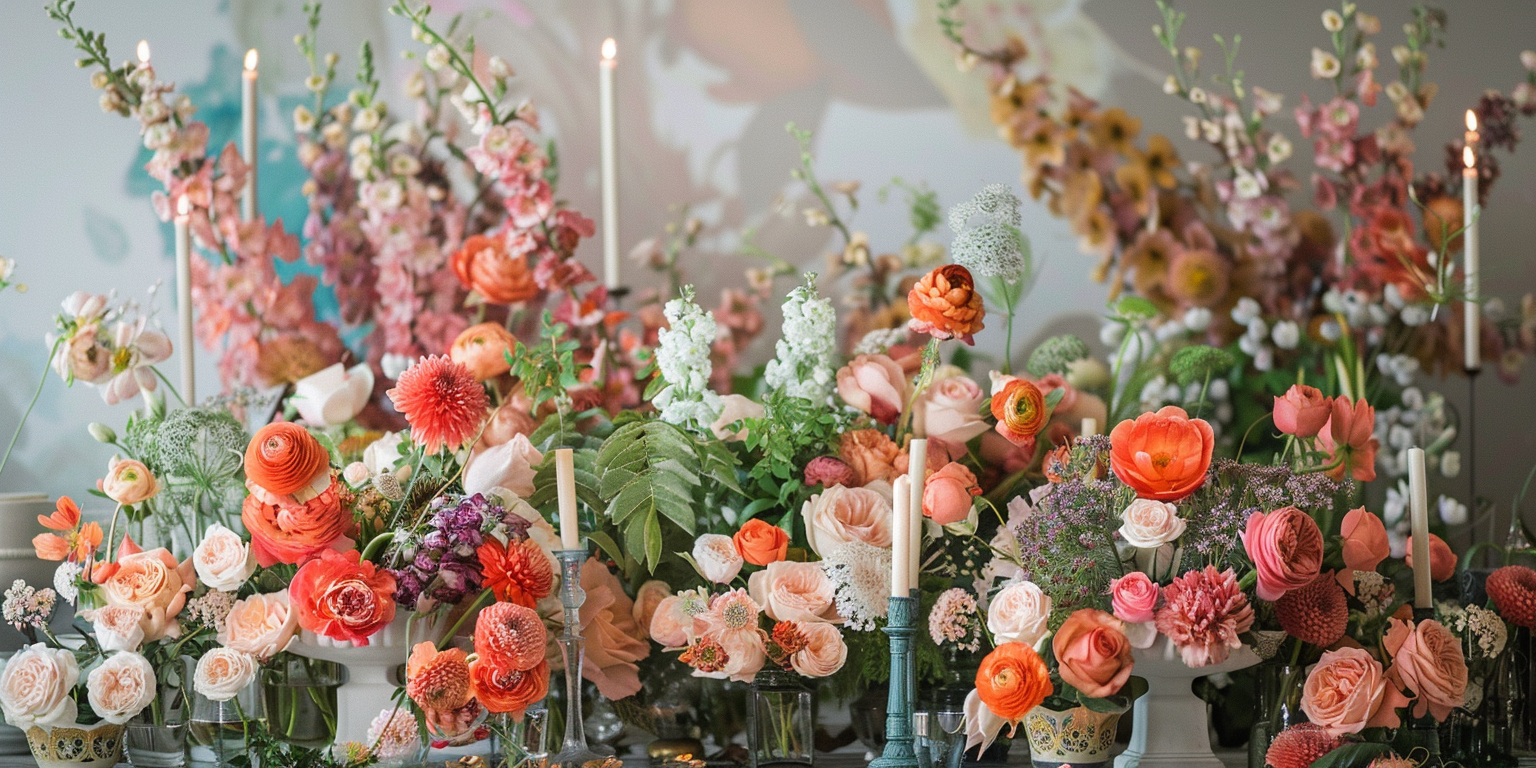
The history of floral design shows how culture, society, and technology have influenced it over time. It dates back to ancient times when people used flowers to decorate their spaces. These flowers and plants had special meanings, symbolizing divinity and beauty. As the years went by, new techniques and styles were introduced, shaping floral design's rich history.
Modern floral design combines old with new, reflecting the changes in art, technology, and lifestyle. It mixes tradition and current trends, keeping the art form vibrant and relevant. Looking at the history of floral design, we can see how it has evolved and stayed vital in our lives for artistic expression and celebrating special moments with beautiful foliage and blossoms.
This article will explore each era in the floral design timeline, showing how it has changed over historical periods and offering a detailed look at the history of flower decoration. It provides a detailed look at the journey of floral design from its beginnings to modern times.
Introduction to Floral Design History
Flower arrangements have a long history. They show us cultures over time, and we see how they've been key to everything from important ceremonies to our parties today.
The journey of floral design began a long time ago. For instance, in Egypt, flowers played a big part in their life and religion. Then, the Greeks made wreaths to show victory and respect, a crucial part of the history of flower decoration.
The Renaissance period was all about beauty and balance. It was an artistic time. Flowers were used in fine ways, making tables and vases pretty. The Victorian Age gave us complex flower meanings, using flowers to say special things.
Many things, like where people lived and what they believed, influenced how flowers were arranged. Each era had its style, including distinctive use of foliage and blossoms. This shows how our love for floral art grew with our cultures over time.
- Egyptian Period
- Greek Period Floral Design
- Renaissance Floral Design History
- Victorian Period Floral Design
This groundwork leads us to a deep look into the development of floral design. It shows us how culture and society changed the way we use flowers.

Ancient Beginnings: Greek Period Floral Design
Ancient Greeks used flowers daily and for ceremonies, starting a tradition we see today. They loved flowers like lilies, narcissus, and violets, making beautiful wreaths. These weren't just pretty; they carried a lot of meaning and were a key part of ceremonies.
Athletes, poets, and soldiers wore wreaths to show honor and victory. They placed garlands in homes and on altars linked to Greek myths. Lilies, for instance, symbolize purity and beauty and belong to Hera, the queen of the gods.
The ancient Greeks wrote about their flower arranging and left artifacts. They focused on creating beauty that was also balanced and harmonious. This method influenced floral design for years to come, even into the Victorian era.
Greek and Roman cultures paved the way for the use of flowers today. Flowers have long been used to show beauty, honor people, and connect to the divine.

The Opulence of the French Period
The French period was famous for its grand floral designs. During Louis XVI's reign, flowers displayed extreme luxury. They were big, beautiful, and very organized, demonstrating what French society liked.
Roses, lilies, peonies, and anemones were often used. These flowers were arranged carefully to show how rich and cultured someone was. The upper class loved elegant, large, and balanced flower decorations.
Over time, French period floral design changed to look more natural, incorporating various plant materials. This change mixed the old luxurious style with new, simpler tastes, setting the stage for more natural and informal styles to become popular.

Renaissance Influences in Floral Arrangements
The Renaissance period saw the popularity of nature and classical ideas return, significantly impacting floral decoration. It changed how people designed floral arrangements. Instead of the older, strict styles, new designs focused on making things look balanced and harmonious. The richness of the time was clear in big gatherings like banquets with colorful, large flower vases. Tulips, peonies, and jasmine were loved both for their looks and what they symbolized.
In the Renaissance, flowers weren't just pretty; they showed what was important to society and art. They were used a lot in events to show beauty with meaning. These flower decorations showed how people saw their creativity and nature as one. This mix was clear in big dinners and the art of that time.
Flowers were more than decorations; they carried deep meanings in everyday life and at special events. For example, tulips were linked with grace, while peonies meant wealth, showcasing their significance in the design became more apparent, much like a modern cornucopia of meanings. Jasmine showed purity with its sweet scent. These flower meanings added a lot to simple displays and the tables at fancy banquets, enriching the floral decoration. They made Renaissance floral designs full of deep symbols.

Victorian Elegance: Floral Design in the Victorian Period
Floral design in the Victorian era was all about elegance. It showed time's strict manners and rules, especially in how designs used foliage. Flowers were arranged as an art, each bunch saying something special. This language of flowers lets people send secret messages with their bouquets. Different flowers were chosen for what they meant, turning every arrangement into a silent talker.
Flowers were a huge part of daily life back then. You'd find them on tables and in personal bouquets a lot. The most used were the simple flowers anyone could find outside. Daisies, for example, stood for being pure and simple, often featured with other blossoms in many designs. By using them, people in the Victorian era added meaning to their homes and personal spaces.
As time went on, people got more creative with flower designs. They began mixing more types of leaves and blooms. This was the era's way of showing changing times, marking a significant point in the history of flower arrangements. The Victorian period was ending, and new styles were starting to show up. It was a turning point in how people decorated flowers.

Transition to Modern Floral Design
The move to modern floral design was a significant change. It shifted from the old to the new, embracing influences from the Baroque period. This update was inspired by the East, particularly Japanese Ikebana, and included more oriental elements like the lotus.
The main focus became asymmetrical shapes and fewer decorations. This Eastern influence made simplicity and balance more important than luxury. Thus, a new design era began.
With time, modern floristry added exotic plants and creative materials. The East and West mixed in design, making unique and varied arrangements. Designs were no longer strictly symmetrical or stiff, allowing for more fluid and dynamic use of foliage.
Recognized as an art, the floral design grew in importance, leading to more elaborate arrangements on banquet tables. Florists mixed styles, like Flemish and Ikebana, creating fresh looks. This mix opened up endless possibilities in floral arrangements.

Key Movements in Modern Floral Design
Modern floral design has changed a lot since the 19th century. Back then, it became recognized as an art in the history of flower arrangements. People started teaching floral design formally, recognizing that floral design became a significant art form.
This change brought new materials and methods, including innovative flower arrangements. Florists began using various plants to make bold, modern arrangements often featured on banquet tables.
Ernst Haeckel's book "Art Forms in Nature" was a big influence. It showed how natural shapes and textures could enhance floral beauty. Thanks to Haeckel, florists started to play with organic, curved styles.
Another key figure is Norah T. Hunter, with her work "The Art of Floral Design." She talked about how floral design has changed over time. News ways of teaching it pushed florists to be more creative. They started breaking the old rules, creating a new floral design style.
The Japanese art of Ikebana also influenced modern floral design. Its focus on simplicity and balance stood out against Europe's more formal designs. Ikebana's influence is clear in today's flowy, lively arrangements.
Modern designers mix many styles, often incorporating Georgian and oriental elements in their floral arrangements. They might take inspiration from gothic designs or natural, flowing forms. This mix lets them make fresh, interesting arrangements that still respect tradition.
The floral design keeps growing and changing. With new tools and materials, the sky's the limit for floral creativity. It's all about making something beautiful and original.

Conclusion: The Future of Floral Design
The future of floral design will focus on being green and using new tech. More people want flowers grown locally and in season to cut carbon, which shows that the floral world is taking big steps for the planet.
New technology is also changing how florists work, making flower arrangements easier to design and visualize. Design software lets them test out complex flower designs on a screen, allowing for innovative styles of floral design. Social media helps them reach more people and show off their work. This mix of tech and flowers is making big waves.
Floral looks will also keep changing to match our world today. They might use different materials and ways that are good for the earth. These shifts bring lots of new chances for the floral industry. With creativity, care for the planet, and tech know-how, the future of flowers is bright.




